Report on the Evolution and Development of Strategic Management
VerifiedAdded on 2020/05/11
|14
|4080
|184
Report
AI Summary
This report offers a comprehensive analysis of the evolution of strategic management, tracing its development from the early influences of scientific management by figures like Fredrick Taylor to contemporary strategic approaches. The report delves into the emergence of strategic management as a distinct discipline, highlighting key concepts, the contributions of influential thinkers such as Chandler and Ansoff, and the shift towards long-term planning and competitive advantage. It explores the evolution of strategic thinking, the impact of industrial organization and economics, and the development of portfolio theory. The report also examines contemporary developments, including systematic approaches to business planning and the integration of strategy formulation across all levels of management. It emphasizes the importance of strategic decision-making, the dynamics of the business environment, and the ongoing debates within the field, providing a detailed overview of the historical context, key concepts, and the progression of strategic management practices.
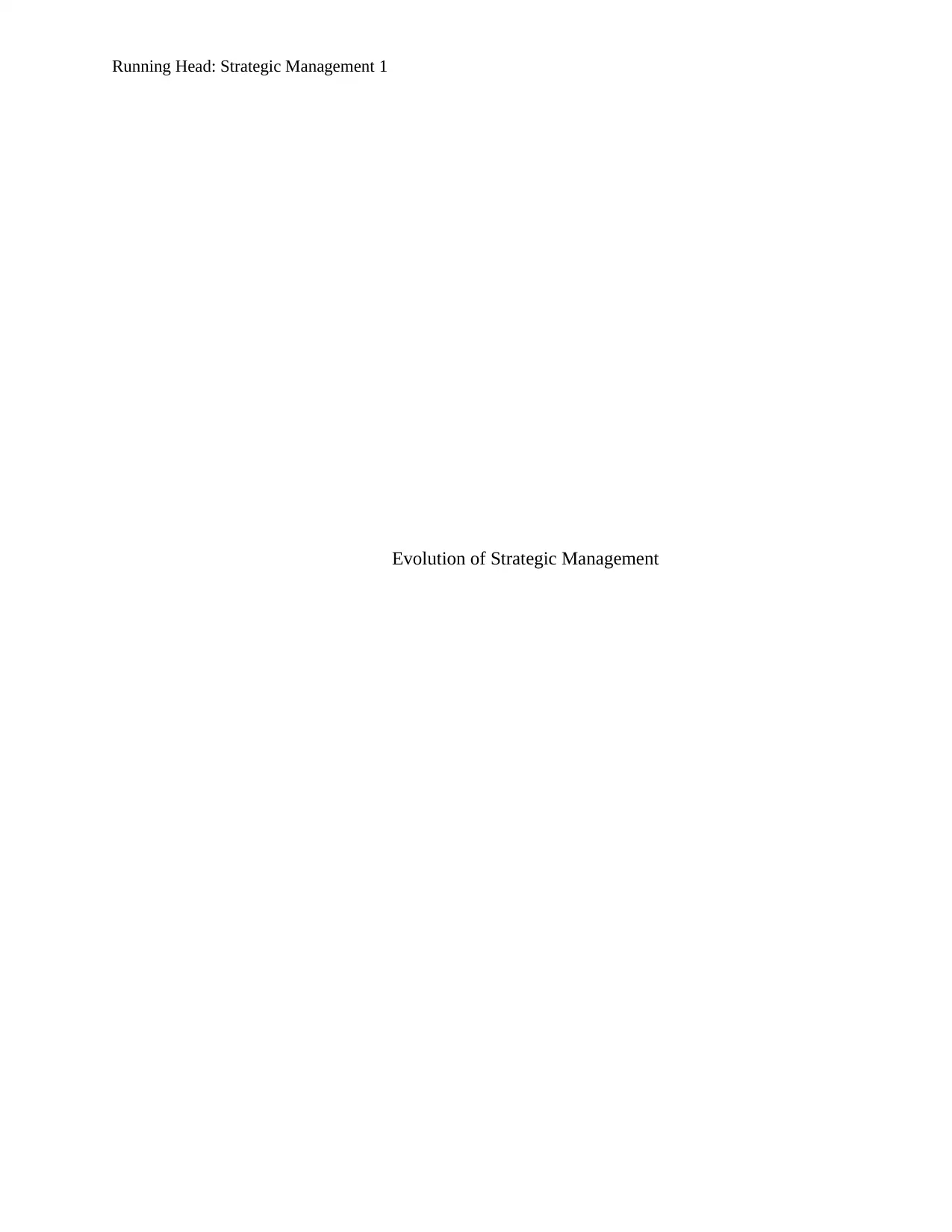
Running Head: Strategic Management 1
Evolution of Strategic Management
Evolution of Strategic Management
Paraphrase This Document
Need a fresh take? Get an instant paraphrase of this document with our AI Paraphraser
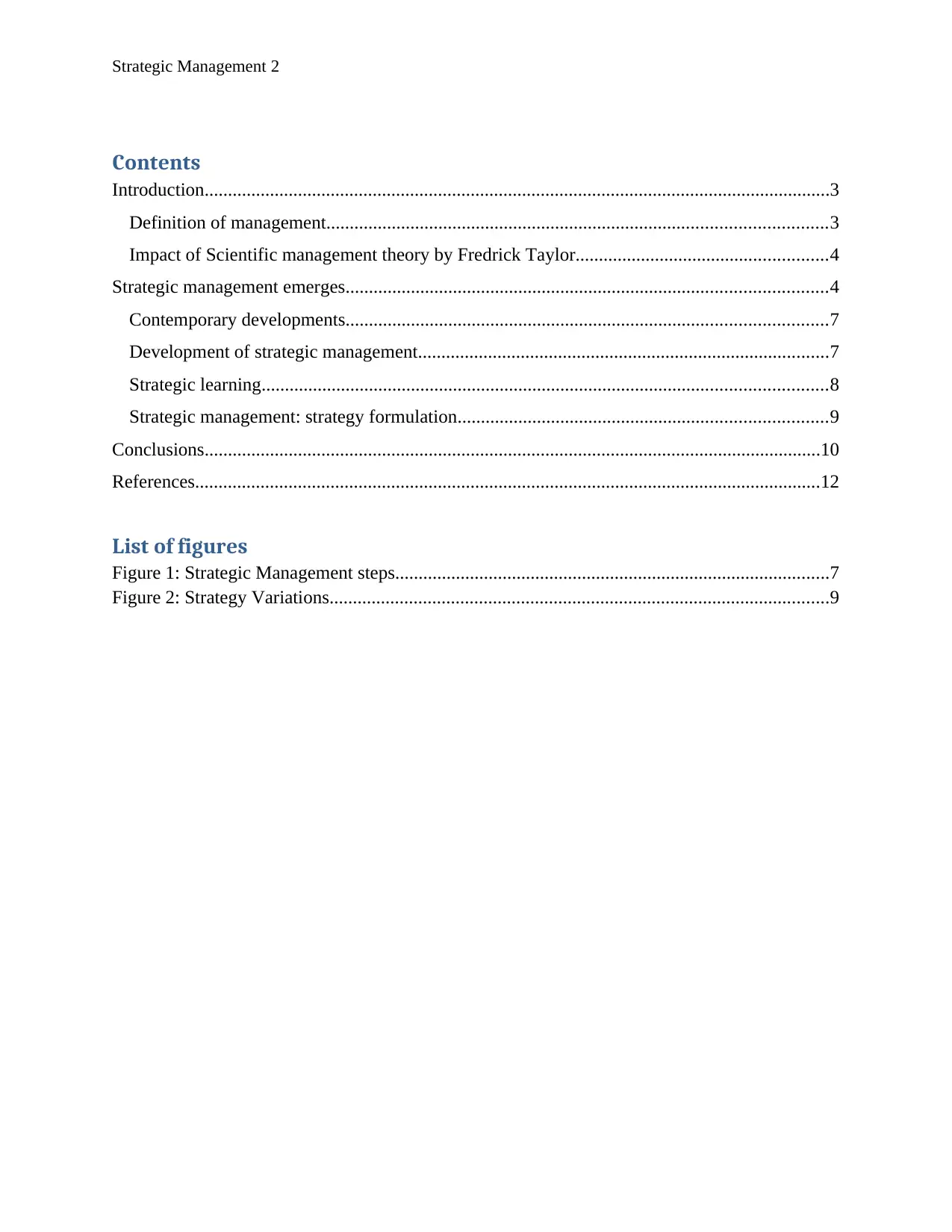
Strategic Management 2
Contents
Introduction......................................................................................................................................3
Definition of management...........................................................................................................3
Impact of Scientific management theory by Fredrick Taylor......................................................4
Strategic management emerges.......................................................................................................4
Contemporary developments.......................................................................................................7
Development of strategic management........................................................................................7
Strategic learning.........................................................................................................................8
Strategic management: strategy formulation...............................................................................9
Conclusions....................................................................................................................................10
References......................................................................................................................................12
List of figures
Figure 1: Strategic Management steps.............................................................................................7
Figure 2: Strategy Variations...........................................................................................................9
Contents
Introduction......................................................................................................................................3
Definition of management...........................................................................................................3
Impact of Scientific management theory by Fredrick Taylor......................................................4
Strategic management emerges.......................................................................................................4
Contemporary developments.......................................................................................................7
Development of strategic management........................................................................................7
Strategic learning.........................................................................................................................8
Strategic management: strategy formulation...............................................................................9
Conclusions....................................................................................................................................10
References......................................................................................................................................12
List of figures
Figure 1: Strategic Management steps.............................................................................................7
Figure 2: Strategy Variations...........................................................................................................9
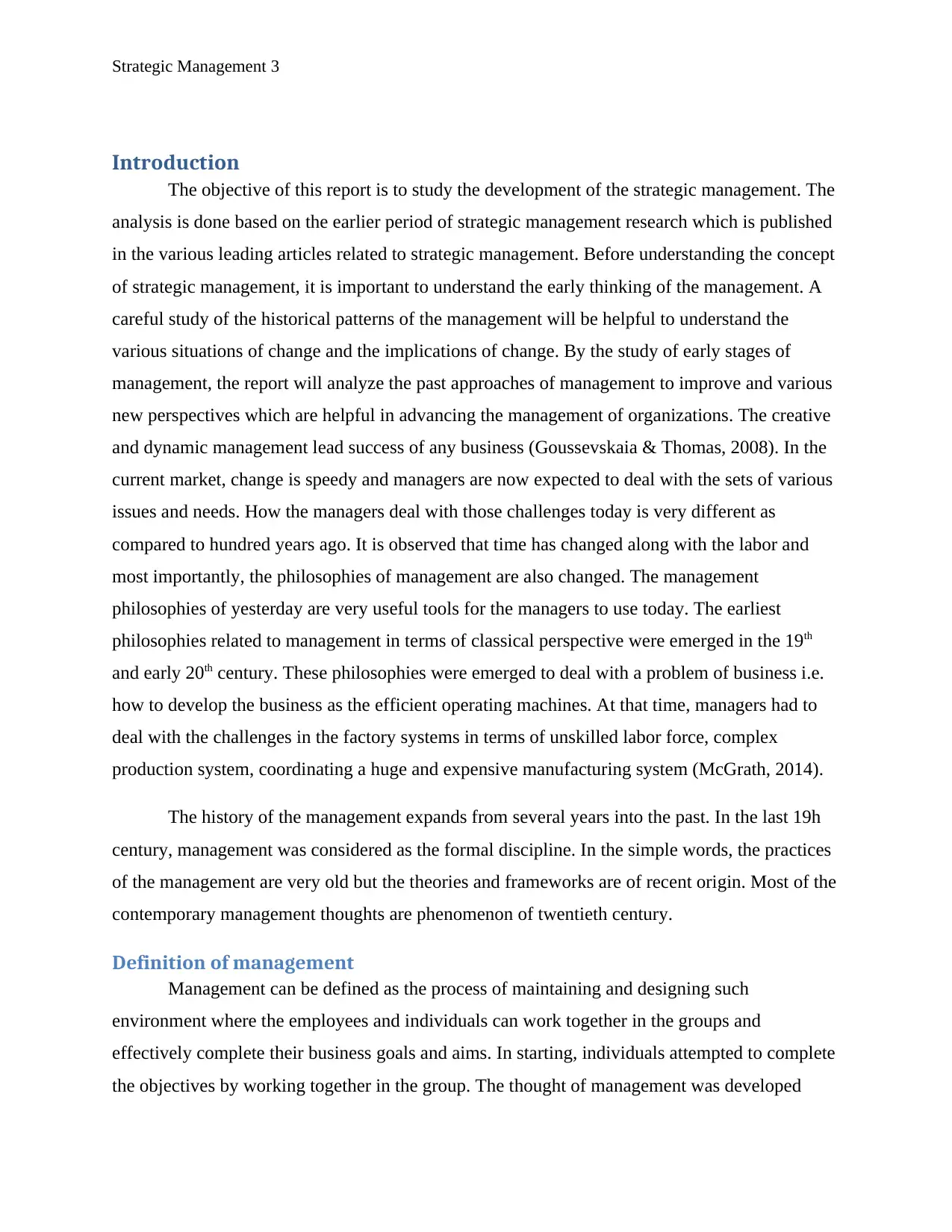
Strategic Management 3
Introduction
The objective of this report is to study the development of the strategic management. The
analysis is done based on the earlier period of strategic management research which is published
in the various leading articles related to strategic management. Before understanding the concept
of strategic management, it is important to understand the early thinking of the management. A
careful study of the historical patterns of the management will be helpful to understand the
various situations of change and the implications of change. By the study of early stages of
management, the report will analyze the past approaches of management to improve and various
new perspectives which are helpful in advancing the management of organizations. The creative
and dynamic management lead success of any business (Goussevskaia & Thomas, 2008). In the
current market, change is speedy and managers are now expected to deal with the sets of various
issues and needs. How the managers deal with those challenges today is very different as
compared to hundred years ago. It is observed that time has changed along with the labor and
most importantly, the philosophies of management are also changed. The management
philosophies of yesterday are very useful tools for the managers to use today. The earliest
philosophies related to management in terms of classical perspective were emerged in the 19th
and early 20th century. These philosophies were emerged to deal with a problem of business i.e.
how to develop the business as the efficient operating machines. At that time, managers had to
deal with the challenges in the factory systems in terms of unskilled labor force, complex
production system, coordinating a huge and expensive manufacturing system (McGrath, 2014).
The history of the management expands from several years into the past. In the last 19h
century, management was considered as the formal discipline. In the simple words, the practices
of the management are very old but the theories and frameworks are of recent origin. Most of the
contemporary management thoughts are phenomenon of twentieth century.
Definition of management
Management can be defined as the process of maintaining and designing such
environment where the employees and individuals can work together in the groups and
effectively complete their business goals and aims. In starting, individuals attempted to complete
the objectives by working together in the group. The thought of management was developed
Introduction
The objective of this report is to study the development of the strategic management. The
analysis is done based on the earlier period of strategic management research which is published
in the various leading articles related to strategic management. Before understanding the concept
of strategic management, it is important to understand the early thinking of the management. A
careful study of the historical patterns of the management will be helpful to understand the
various situations of change and the implications of change. By the study of early stages of
management, the report will analyze the past approaches of management to improve and various
new perspectives which are helpful in advancing the management of organizations. The creative
and dynamic management lead success of any business (Goussevskaia & Thomas, 2008). In the
current market, change is speedy and managers are now expected to deal with the sets of various
issues and needs. How the managers deal with those challenges today is very different as
compared to hundred years ago. It is observed that time has changed along with the labor and
most importantly, the philosophies of management are also changed. The management
philosophies of yesterday are very useful tools for the managers to use today. The earliest
philosophies related to management in terms of classical perspective were emerged in the 19th
and early 20th century. These philosophies were emerged to deal with a problem of business i.e.
how to develop the business as the efficient operating machines. At that time, managers had to
deal with the challenges in the factory systems in terms of unskilled labor force, complex
production system, coordinating a huge and expensive manufacturing system (McGrath, 2014).
The history of the management expands from several years into the past. In the last 19h
century, management was considered as the formal discipline. In the simple words, the practices
of the management are very old but the theories and frameworks are of recent origin. Most of the
contemporary management thoughts are phenomenon of twentieth century.
Definition of management
Management can be defined as the process of maintaining and designing such
environment where the employees and individuals can work together in the groups and
effectively complete their business goals and aims. In starting, individuals attempted to complete
the objectives by working together in the group. The thought of management was developed
⊘ This is a preview!⊘
Do you want full access?
Subscribe today to unlock all pages.

Trusted by 1+ million students worldwide
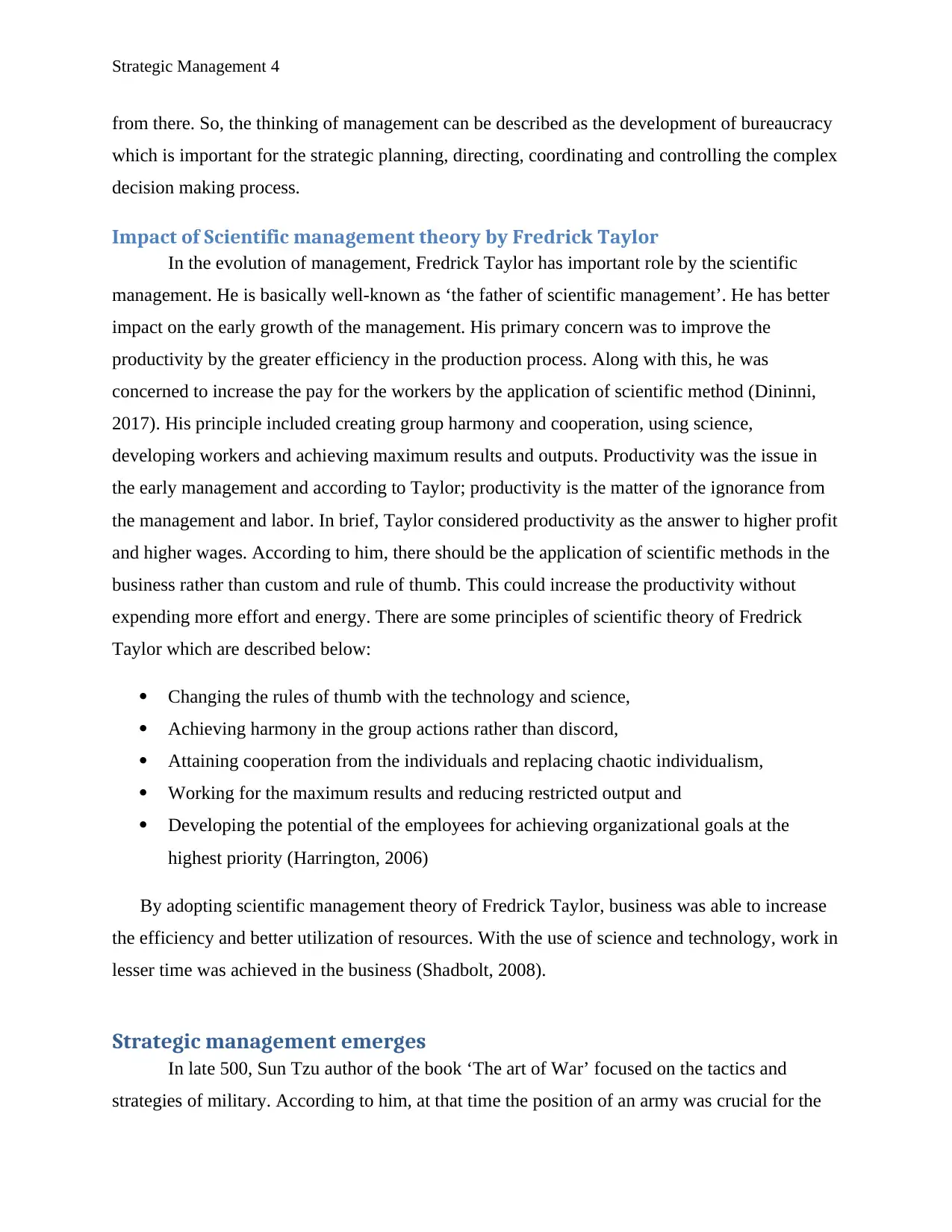
Strategic Management 4
from there. So, the thinking of management can be described as the development of bureaucracy
which is important for the strategic planning, directing, coordinating and controlling the complex
decision making process.
Impact of Scientific management theory by Fredrick Taylor
In the evolution of management, Fredrick Taylor has important role by the scientific
management. He is basically well-known as ‘the father of scientific management’. He has better
impact on the early growth of the management. His primary concern was to improve the
productivity by the greater efficiency in the production process. Along with this, he was
concerned to increase the pay for the workers by the application of scientific method (Dininni,
2017). His principle included creating group harmony and cooperation, using science,
developing workers and achieving maximum results and outputs. Productivity was the issue in
the early management and according to Taylor; productivity is the matter of the ignorance from
the management and labor. In brief, Taylor considered productivity as the answer to higher profit
and higher wages. According to him, there should be the application of scientific methods in the
business rather than custom and rule of thumb. This could increase the productivity without
expending more effort and energy. There are some principles of scientific theory of Fredrick
Taylor which are described below:
Changing the rules of thumb with the technology and science,
Achieving harmony in the group actions rather than discord,
Attaining cooperation from the individuals and replacing chaotic individualism,
Working for the maximum results and reducing restricted output and
Developing the potential of the employees for achieving organizational goals at the
highest priority (Harrington, 2006)
By adopting scientific management theory of Fredrick Taylor, business was able to increase
the efficiency and better utilization of resources. With the use of science and technology, work in
lesser time was achieved in the business (Shadbolt, 2008).
Strategic management emerges
In late 500, Sun Tzu author of the book ‘The art of War’ focused on the tactics and
strategies of military. According to him, at that time the position of an army was crucial for the
from there. So, the thinking of management can be described as the development of bureaucracy
which is important for the strategic planning, directing, coordinating and controlling the complex
decision making process.
Impact of Scientific management theory by Fredrick Taylor
In the evolution of management, Fredrick Taylor has important role by the scientific
management. He is basically well-known as ‘the father of scientific management’. He has better
impact on the early growth of the management. His primary concern was to improve the
productivity by the greater efficiency in the production process. Along with this, he was
concerned to increase the pay for the workers by the application of scientific method (Dininni,
2017). His principle included creating group harmony and cooperation, using science,
developing workers and achieving maximum results and outputs. Productivity was the issue in
the early management and according to Taylor; productivity is the matter of the ignorance from
the management and labor. In brief, Taylor considered productivity as the answer to higher profit
and higher wages. According to him, there should be the application of scientific methods in the
business rather than custom and rule of thumb. This could increase the productivity without
expending more effort and energy. There are some principles of scientific theory of Fredrick
Taylor which are described below:
Changing the rules of thumb with the technology and science,
Achieving harmony in the group actions rather than discord,
Attaining cooperation from the individuals and replacing chaotic individualism,
Working for the maximum results and reducing restricted output and
Developing the potential of the employees for achieving organizational goals at the
highest priority (Harrington, 2006)
By adopting scientific management theory of Fredrick Taylor, business was able to increase
the efficiency and better utilization of resources. With the use of science and technology, work in
lesser time was achieved in the business (Shadbolt, 2008).
Strategic management emerges
In late 500, Sun Tzu author of the book ‘The art of War’ focused on the tactics and
strategies of military. According to him, at that time the position of an army was crucial for the
Paraphrase This Document
Need a fresh take? Get an instant paraphrase of this document with our AI Paraphraser
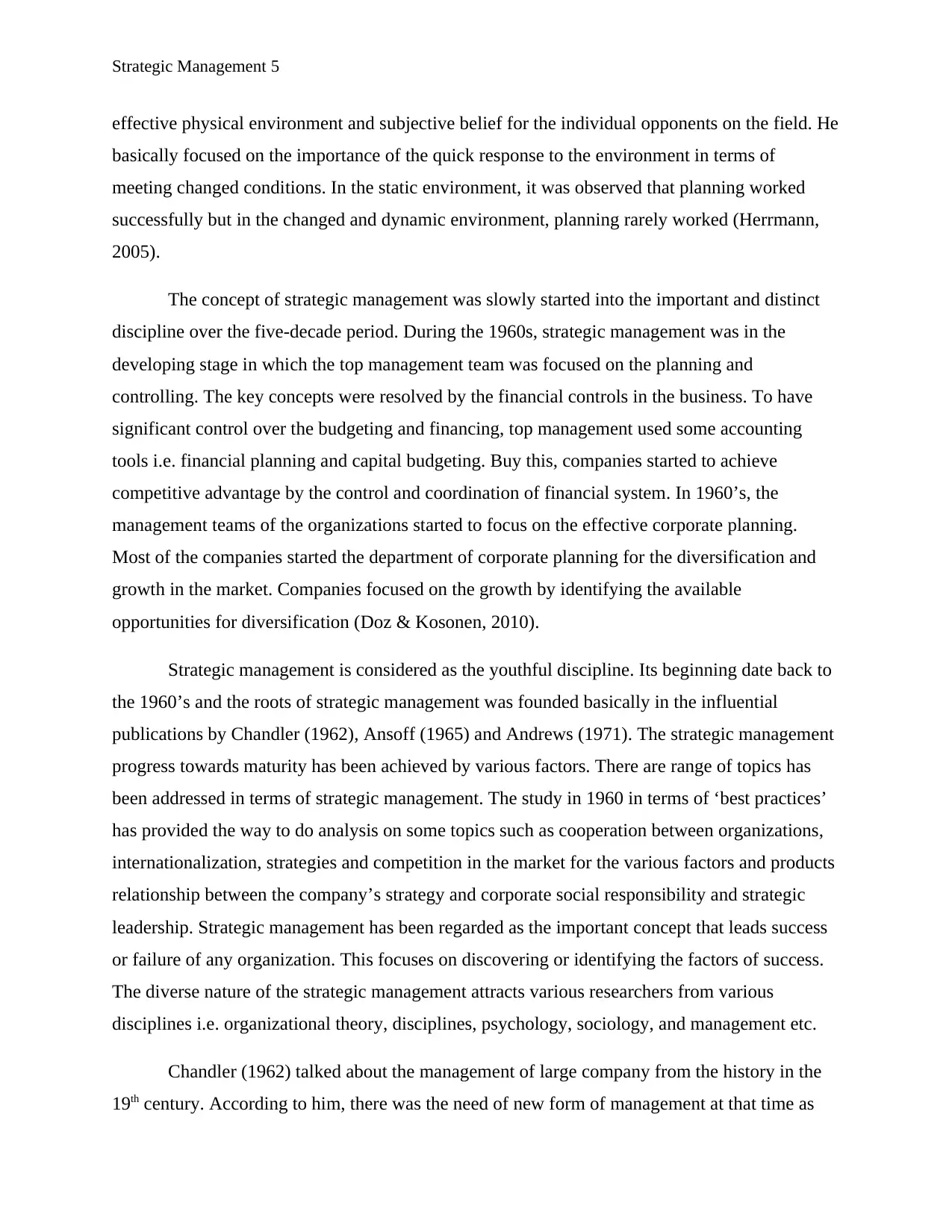
Strategic Management 5
effective physical environment and subjective belief for the individual opponents on the field. He
basically focused on the importance of the quick response to the environment in terms of
meeting changed conditions. In the static environment, it was observed that planning worked
successfully but in the changed and dynamic environment, planning rarely worked (Herrmann,
2005).
The concept of strategic management was slowly started into the important and distinct
discipline over the five-decade period. During the 1960s, strategic management was in the
developing stage in which the top management team was focused on the planning and
controlling. The key concepts were resolved by the financial controls in the business. To have
significant control over the budgeting and financing, top management used some accounting
tools i.e. financial planning and capital budgeting. Buy this, companies started to achieve
competitive advantage by the control and coordination of financial system. In 1960’s, the
management teams of the organizations started to focus on the effective corporate planning.
Most of the companies started the department of corporate planning for the diversification and
growth in the market. Companies focused on the growth by identifying the available
opportunities for diversification (Doz & Kosonen, 2010).
Strategic management is considered as the youthful discipline. Its beginning date back to
the 1960’s and the roots of strategic management was founded basically in the influential
publications by Chandler (1962), Ansoff (1965) and Andrews (1971). The strategic management
progress towards maturity has been achieved by various factors. There are range of topics has
been addressed in terms of strategic management. The study in 1960 in terms of ‘best practices’
has provided the way to do analysis on some topics such as cooperation between organizations,
internationalization, strategies and competition in the market for the various factors and products
relationship between the company’s strategy and corporate social responsibility and strategic
leadership. Strategic management has been regarded as the important concept that leads success
or failure of any organization. This focuses on discovering or identifying the factors of success.
The diverse nature of the strategic management attracts various researchers from various
disciplines i.e. organizational theory, disciplines, psychology, sociology, and management etc.
Chandler (1962) talked about the management of large company from the history in the
19th century. According to him, there was the need of new form of management at that time as
effective physical environment and subjective belief for the individual opponents on the field. He
basically focused on the importance of the quick response to the environment in terms of
meeting changed conditions. In the static environment, it was observed that planning worked
successfully but in the changed and dynamic environment, planning rarely worked (Herrmann,
2005).
The concept of strategic management was slowly started into the important and distinct
discipline over the five-decade period. During the 1960s, strategic management was in the
developing stage in which the top management team was focused on the planning and
controlling. The key concepts were resolved by the financial controls in the business. To have
significant control over the budgeting and financing, top management used some accounting
tools i.e. financial planning and capital budgeting. Buy this, companies started to achieve
competitive advantage by the control and coordination of financial system. In 1960’s, the
management teams of the organizations started to focus on the effective corporate planning.
Most of the companies started the department of corporate planning for the diversification and
growth in the market. Companies focused on the growth by identifying the available
opportunities for diversification (Doz & Kosonen, 2010).
Strategic management is considered as the youthful discipline. Its beginning date back to
the 1960’s and the roots of strategic management was founded basically in the influential
publications by Chandler (1962), Ansoff (1965) and Andrews (1971). The strategic management
progress towards maturity has been achieved by various factors. There are range of topics has
been addressed in terms of strategic management. The study in 1960 in terms of ‘best practices’
has provided the way to do analysis on some topics such as cooperation between organizations,
internationalization, strategies and competition in the market for the various factors and products
relationship between the company’s strategy and corporate social responsibility and strategic
leadership. Strategic management has been regarded as the important concept that leads success
or failure of any organization. This focuses on discovering or identifying the factors of success.
The diverse nature of the strategic management attracts various researchers from various
disciplines i.e. organizational theory, disciplines, psychology, sociology, and management etc.
Chandler (1962) talked about the management of large company from the history in the
19th century. According to him, there was the need of new form of management at that time as
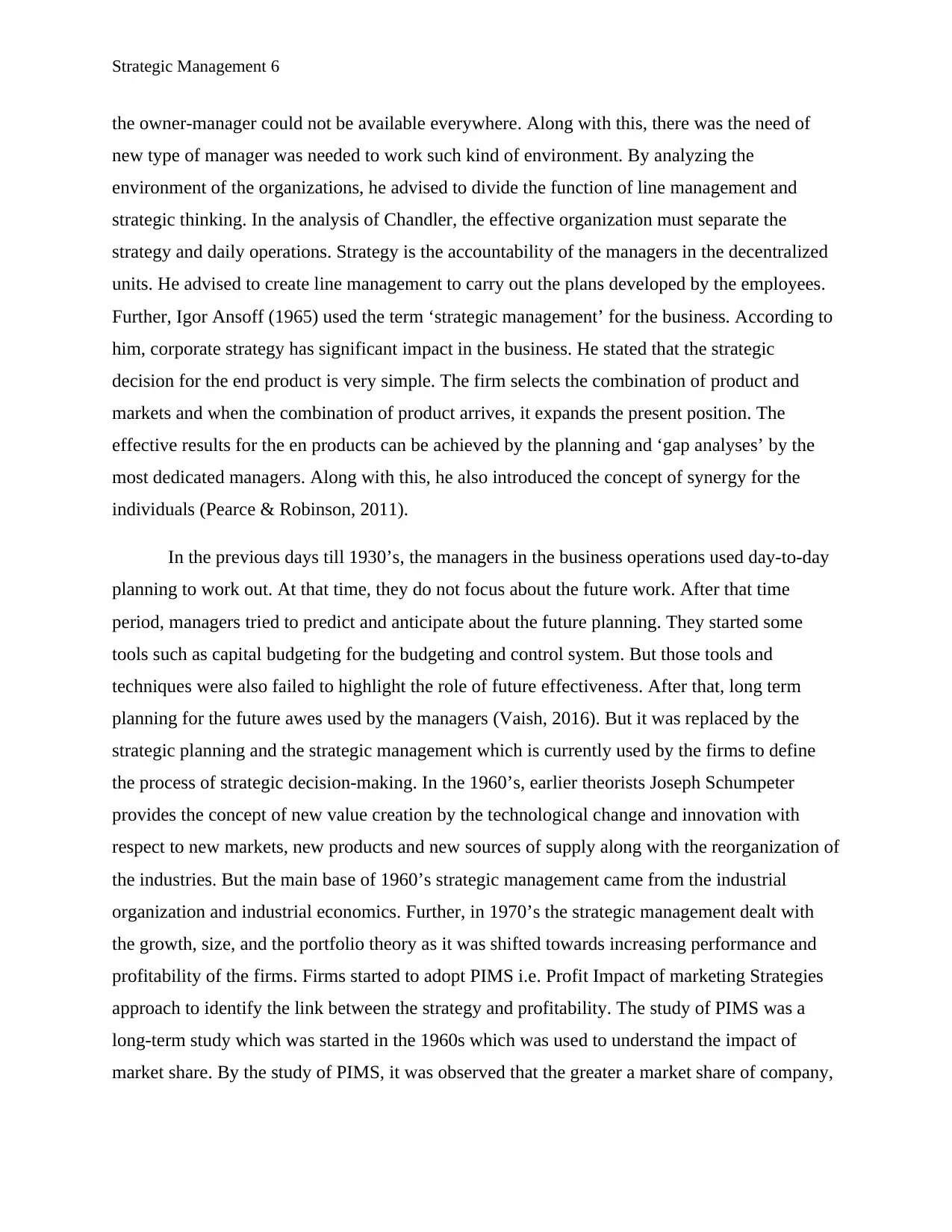
Strategic Management 6
the owner-manager could not be available everywhere. Along with this, there was the need of
new type of manager was needed to work such kind of environment. By analyzing the
environment of the organizations, he advised to divide the function of line management and
strategic thinking. In the analysis of Chandler, the effective organization must separate the
strategy and daily operations. Strategy is the accountability of the managers in the decentralized
units. He advised to create line management to carry out the plans developed by the employees.
Further, Igor Ansoff (1965) used the term ‘strategic management’ for the business. According to
him, corporate strategy has significant impact in the business. He stated that the strategic
decision for the end product is very simple. The firm selects the combination of product and
markets and when the combination of product arrives, it expands the present position. The
effective results for the en products can be achieved by the planning and ‘gap analyses’ by the
most dedicated managers. Along with this, he also introduced the concept of synergy for the
individuals (Pearce & Robinson, 2011).
In the previous days till 1930’s, the managers in the business operations used day-to-day
planning to work out. At that time, they do not focus about the future work. After that time
period, managers tried to predict and anticipate about the future planning. They started some
tools such as capital budgeting for the budgeting and control system. But those tools and
techniques were also failed to highlight the role of future effectiveness. After that, long term
planning for the future awes used by the managers (Vaish, 2016). But it was replaced by the
strategic planning and the strategic management which is currently used by the firms to define
the process of strategic decision-making. In the 1960’s, earlier theorists Joseph Schumpeter
provides the concept of new value creation by the technological change and innovation with
respect to new markets, new products and new sources of supply along with the reorganization of
the industries. But the main base of 1960’s strategic management came from the industrial
organization and industrial economics. Further, in 1970’s the strategic management dealt with
the growth, size, and the portfolio theory as it was shifted towards increasing performance and
profitability of the firms. Firms started to adopt PIMS i.e. Profit Impact of marketing Strategies
approach to identify the link between the strategy and profitability. The study of PIMS was a
long-term study which was started in the 1960s which was used to understand the impact of
market share. By the study of PIMS, it was observed that the greater a market share of company,
the owner-manager could not be available everywhere. Along with this, there was the need of
new type of manager was needed to work such kind of environment. By analyzing the
environment of the organizations, he advised to divide the function of line management and
strategic thinking. In the analysis of Chandler, the effective organization must separate the
strategy and daily operations. Strategy is the accountability of the managers in the decentralized
units. He advised to create line management to carry out the plans developed by the employees.
Further, Igor Ansoff (1965) used the term ‘strategic management’ for the business. According to
him, corporate strategy has significant impact in the business. He stated that the strategic
decision for the end product is very simple. The firm selects the combination of product and
markets and when the combination of product arrives, it expands the present position. The
effective results for the en products can be achieved by the planning and ‘gap analyses’ by the
most dedicated managers. Along with this, he also introduced the concept of synergy for the
individuals (Pearce & Robinson, 2011).
In the previous days till 1930’s, the managers in the business operations used day-to-day
planning to work out. At that time, they do not focus about the future work. After that time
period, managers tried to predict and anticipate about the future planning. They started some
tools such as capital budgeting for the budgeting and control system. But those tools and
techniques were also failed to highlight the role of future effectiveness. After that, long term
planning for the future awes used by the managers (Vaish, 2016). But it was replaced by the
strategic planning and the strategic management which is currently used by the firms to define
the process of strategic decision-making. In the 1960’s, earlier theorists Joseph Schumpeter
provides the concept of new value creation by the technological change and innovation with
respect to new markets, new products and new sources of supply along with the reorganization of
the industries. But the main base of 1960’s strategic management came from the industrial
organization and industrial economics. Further, in 1970’s the strategic management dealt with
the growth, size, and the portfolio theory as it was shifted towards increasing performance and
profitability of the firms. Firms started to adopt PIMS i.e. Profit Impact of marketing Strategies
approach to identify the link between the strategy and profitability. The study of PIMS was a
long-term study which was started in the 1960s which was used to understand the impact of
market share. By the study of PIMS, it was observed that the greater a market share of company,
⊘ This is a preview!⊘
Do you want full access?
Subscribe today to unlock all pages.

Trusted by 1+ million students worldwide
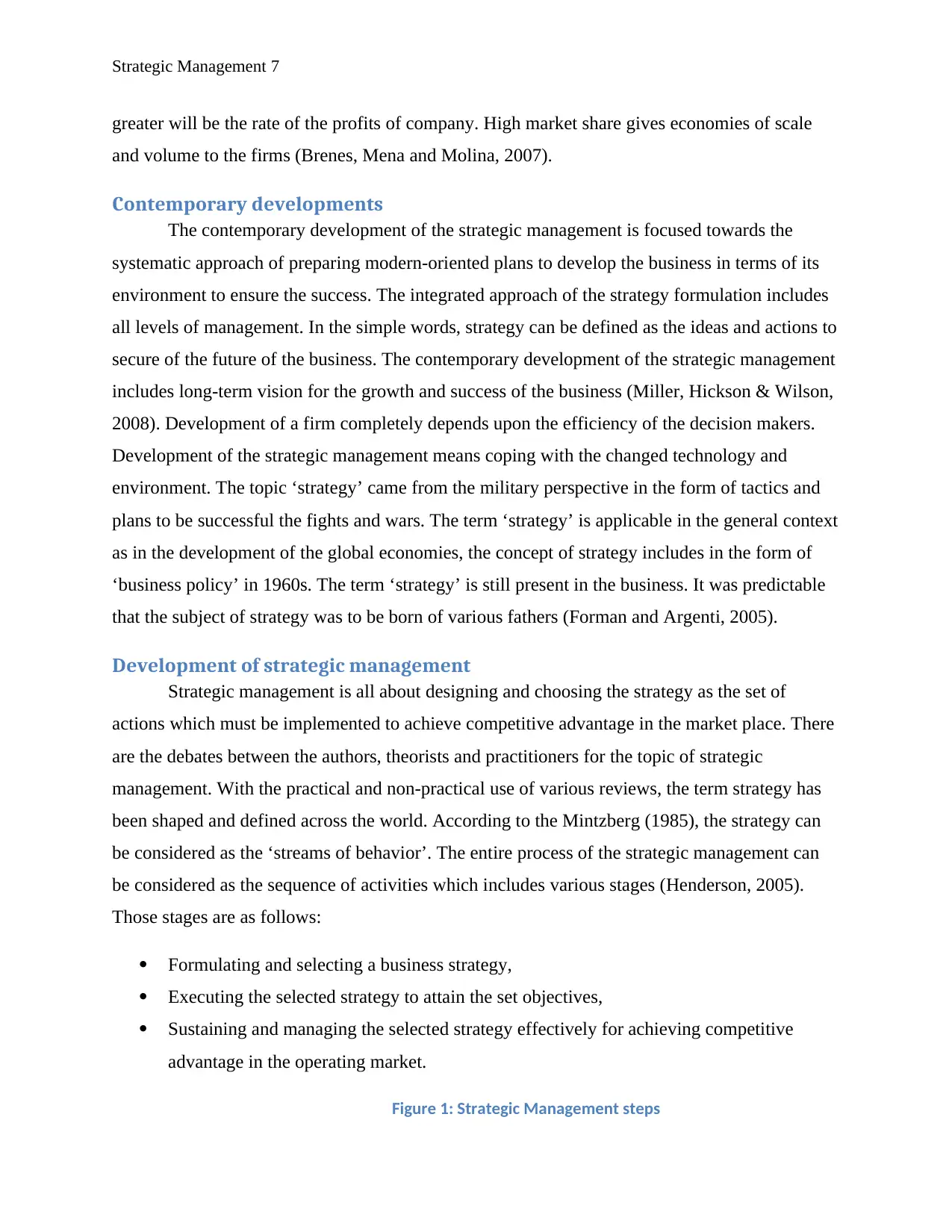
Strategic Management 7
greater will be the rate of the profits of company. High market share gives economies of scale
and volume to the firms (Brenes, Mena and Molina, 2007).
Contemporary developments
The contemporary development of the strategic management is focused towards the
systematic approach of preparing modern-oriented plans to develop the business in terms of its
environment to ensure the success. The integrated approach of the strategy formulation includes
all levels of management. In the simple words, strategy can be defined as the ideas and actions to
secure of the future of the business. The contemporary development of the strategic management
includes long-term vision for the growth and success of the business (Miller, Hickson & Wilson,
2008). Development of a firm completely depends upon the efficiency of the decision makers.
Development of the strategic management means coping with the changed technology and
environment. The topic ‘strategy’ came from the military perspective in the form of tactics and
plans to be successful the fights and wars. The term ‘strategy’ is applicable in the general context
as in the development of the global economies, the concept of strategy includes in the form of
‘business policy’ in 1960s. The term ‘strategy’ is still present in the business. It was predictable
that the subject of strategy was to be born of various fathers (Forman and Argenti, 2005).
Development of strategic management
Strategic management is all about designing and choosing the strategy as the set of
actions which must be implemented to achieve competitive advantage in the market place. There
are the debates between the authors, theorists and practitioners for the topic of strategic
management. With the practical and non-practical use of various reviews, the term strategy has
been shaped and defined across the world. According to the Mintzberg (1985), the strategy can
be considered as the ‘streams of behavior’. The entire process of the strategic management can
be considered as the sequence of activities which includes various stages (Henderson, 2005).
Those stages are as follows:
Formulating and selecting a business strategy,
Executing the selected strategy to attain the set objectives,
Sustaining and managing the selected strategy effectively for achieving competitive
advantage in the operating market.
Figure 1: Strategic Management steps
greater will be the rate of the profits of company. High market share gives economies of scale
and volume to the firms (Brenes, Mena and Molina, 2007).
Contemporary developments
The contemporary development of the strategic management is focused towards the
systematic approach of preparing modern-oriented plans to develop the business in terms of its
environment to ensure the success. The integrated approach of the strategy formulation includes
all levels of management. In the simple words, strategy can be defined as the ideas and actions to
secure of the future of the business. The contemporary development of the strategic management
includes long-term vision for the growth and success of the business (Miller, Hickson & Wilson,
2008). Development of a firm completely depends upon the efficiency of the decision makers.
Development of the strategic management means coping with the changed technology and
environment. The topic ‘strategy’ came from the military perspective in the form of tactics and
plans to be successful the fights and wars. The term ‘strategy’ is applicable in the general context
as in the development of the global economies, the concept of strategy includes in the form of
‘business policy’ in 1960s. The term ‘strategy’ is still present in the business. It was predictable
that the subject of strategy was to be born of various fathers (Forman and Argenti, 2005).
Development of strategic management
Strategic management is all about designing and choosing the strategy as the set of
actions which must be implemented to achieve competitive advantage in the market place. There
are the debates between the authors, theorists and practitioners for the topic of strategic
management. With the practical and non-practical use of various reviews, the term strategy has
been shaped and defined across the world. According to the Mintzberg (1985), the strategy can
be considered as the ‘streams of behavior’. The entire process of the strategic management can
be considered as the sequence of activities which includes various stages (Henderson, 2005).
Those stages are as follows:
Formulating and selecting a business strategy,
Executing the selected strategy to attain the set objectives,
Sustaining and managing the selected strategy effectively for achieving competitive
advantage in the operating market.
Figure 1: Strategic Management steps
Paraphrase This Document
Need a fresh take? Get an instant paraphrase of this document with our AI Paraphraser
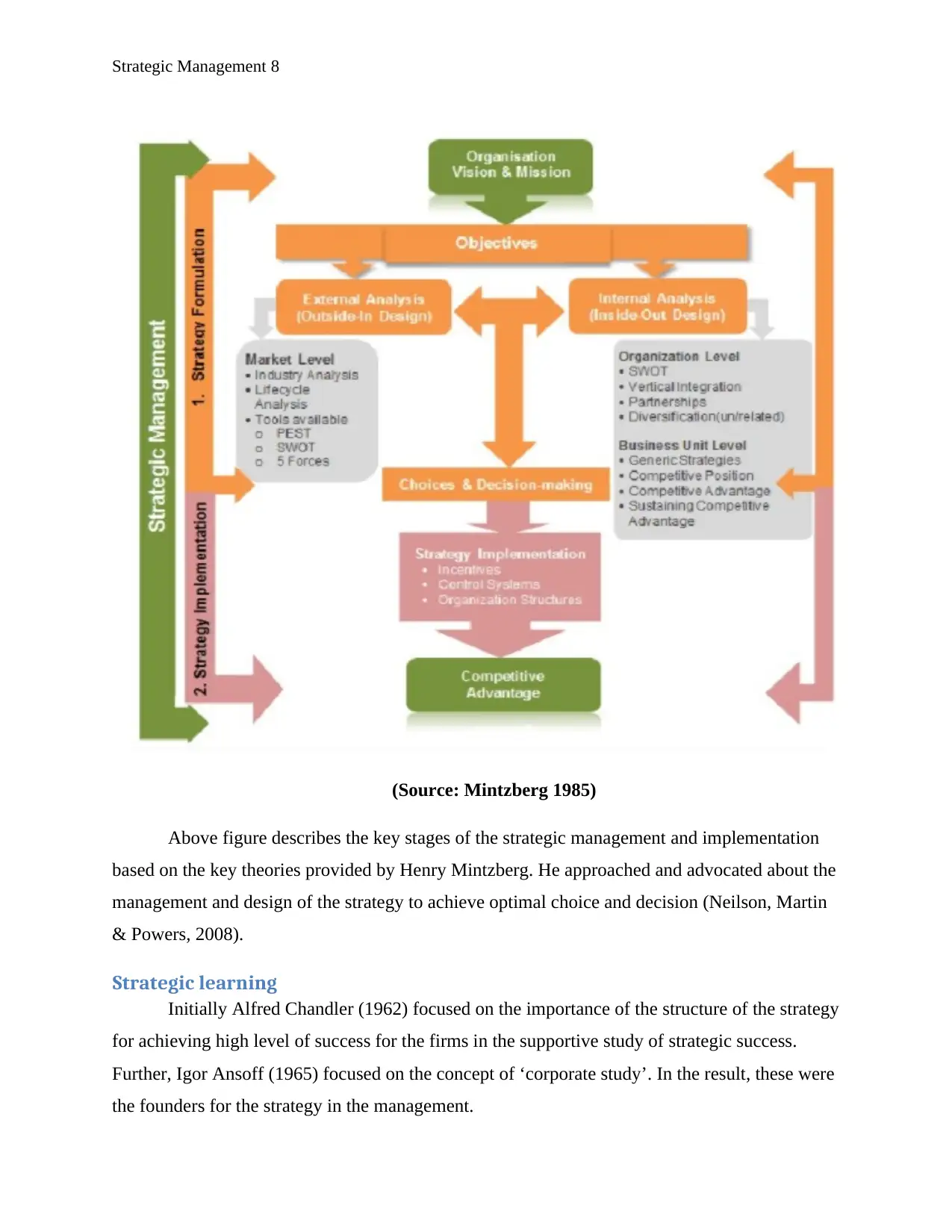
Strategic Management 8
(Source: Mintzberg 1985)
Above figure describes the key stages of the strategic management and implementation
based on the key theories provided by Henry Mintzberg. He approached and advocated about the
management and design of the strategy to achieve optimal choice and decision (Neilson, Martin
& Powers, 2008).
Strategic learning
Initially Alfred Chandler (1962) focused on the importance of the structure of the strategy
for achieving high level of success for the firms in the supportive study of strategic success.
Further, Igor Ansoff (1965) focused on the concept of ‘corporate study’. In the result, these were
the founders for the strategy in the management.
(Source: Mintzberg 1985)
Above figure describes the key stages of the strategic management and implementation
based on the key theories provided by Henry Mintzberg. He approached and advocated about the
management and design of the strategy to achieve optimal choice and decision (Neilson, Martin
& Powers, 2008).
Strategic learning
Initially Alfred Chandler (1962) focused on the importance of the structure of the strategy
for achieving high level of success for the firms in the supportive study of strategic success.
Further, Igor Ansoff (1965) focused on the concept of ‘corporate study’. In the result, these were
the founders for the strategy in the management.
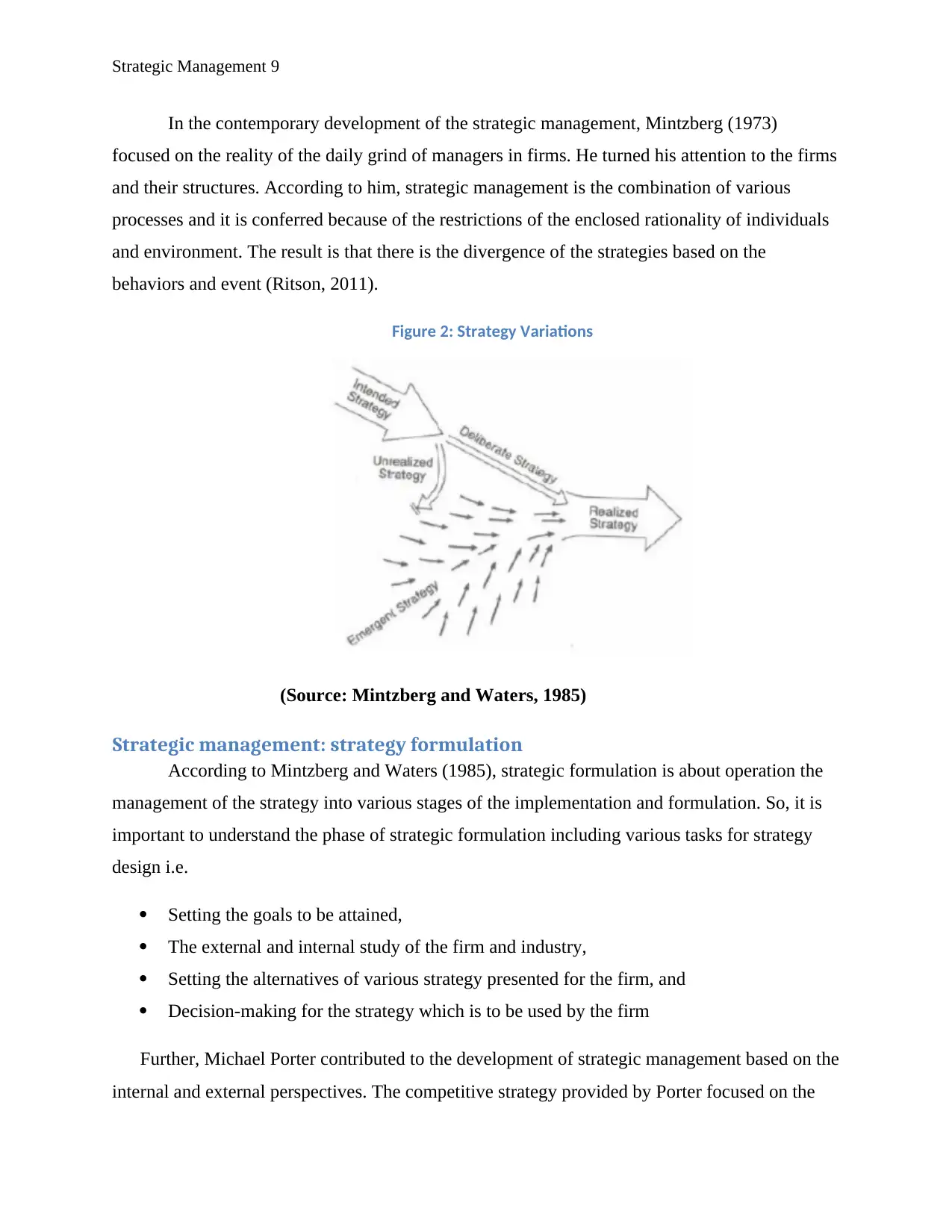
Strategic Management 9
In the contemporary development of the strategic management, Mintzberg (1973)
focused on the reality of the daily grind of managers in firms. He turned his attention to the firms
and their structures. According to him, strategic management is the combination of various
processes and it is conferred because of the restrictions of the enclosed rationality of individuals
and environment. The result is that there is the divergence of the strategies based on the
behaviors and event (Ritson, 2011).
Figure 2: Strategy Variations
(Source: Mintzberg and Waters, 1985)
Strategic management: strategy formulation
According to Mintzberg and Waters (1985), strategic formulation is about operation the
management of the strategy into various stages of the implementation and formulation. So, it is
important to understand the phase of strategic formulation including various tasks for strategy
design i.e.
Setting the goals to be attained,
The external and internal study of the firm and industry,
Setting the alternatives of various strategy presented for the firm, and
Decision-making for the strategy which is to be used by the firm
Further, Michael Porter contributed to the development of strategic management based on the
internal and external perspectives. The competitive strategy provided by Porter focused on the
In the contemporary development of the strategic management, Mintzberg (1973)
focused on the reality of the daily grind of managers in firms. He turned his attention to the firms
and their structures. According to him, strategic management is the combination of various
processes and it is conferred because of the restrictions of the enclosed rationality of individuals
and environment. The result is that there is the divergence of the strategies based on the
behaviors and event (Ritson, 2011).
Figure 2: Strategy Variations
(Source: Mintzberg and Waters, 1985)
Strategic management: strategy formulation
According to Mintzberg and Waters (1985), strategic formulation is about operation the
management of the strategy into various stages of the implementation and formulation. So, it is
important to understand the phase of strategic formulation including various tasks for strategy
design i.e.
Setting the goals to be attained,
The external and internal study of the firm and industry,
Setting the alternatives of various strategy presented for the firm, and
Decision-making for the strategy which is to be used by the firm
Further, Michael Porter contributed to the development of strategic management based on the
internal and external perspectives. The competitive strategy provided by Porter focused on the
⊘ This is a preview!⊘
Do you want full access?
Subscribe today to unlock all pages.

Trusted by 1+ million students worldwide
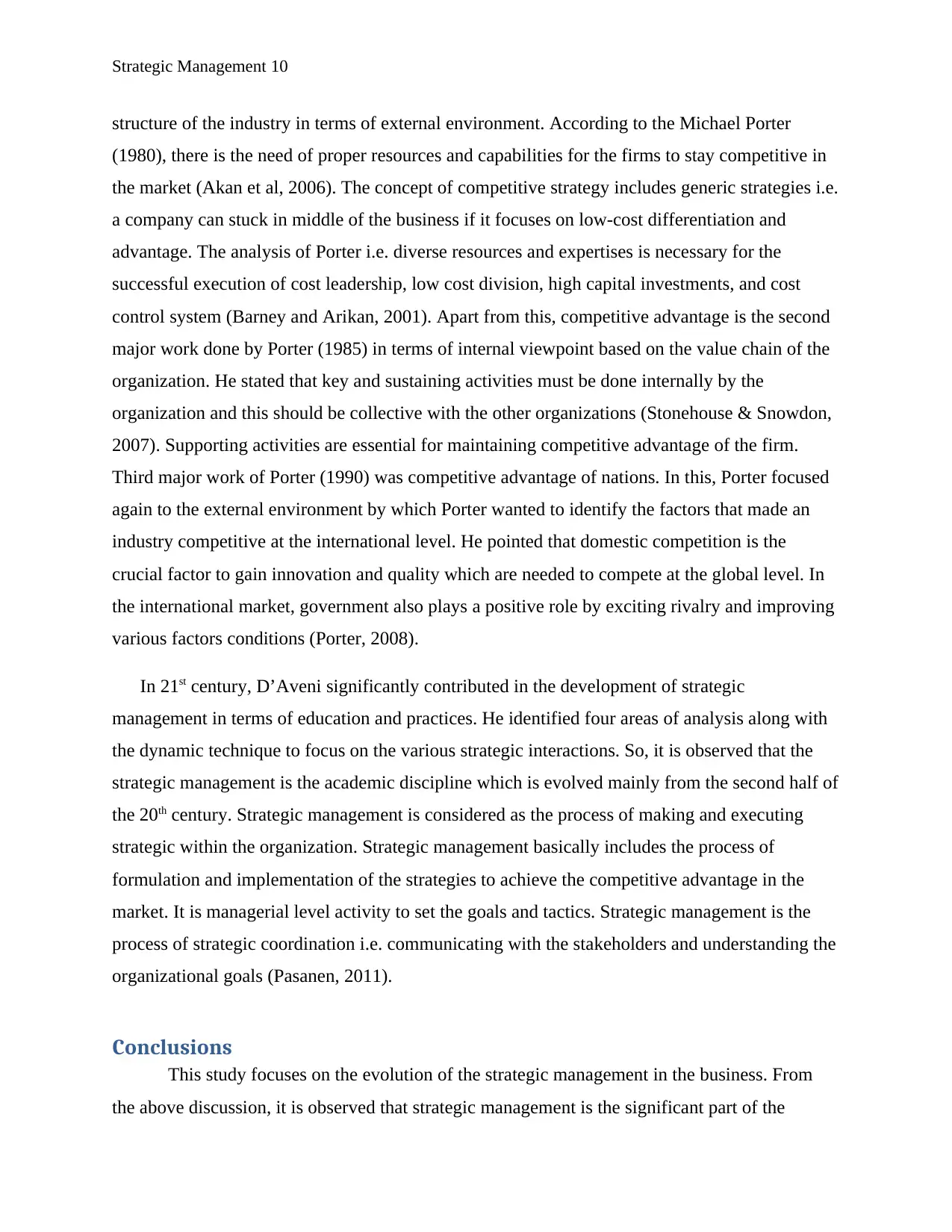
Strategic Management 10
structure of the industry in terms of external environment. According to the Michael Porter
(1980), there is the need of proper resources and capabilities for the firms to stay competitive in
the market (Akan et al, 2006). The concept of competitive strategy includes generic strategies i.e.
a company can stuck in middle of the business if it focuses on low-cost differentiation and
advantage. The analysis of Porter i.e. diverse resources and expertises is necessary for the
successful execution of cost leadership, low cost division, high capital investments, and cost
control system (Barney and Arikan, 2001). Apart from this, competitive advantage is the second
major work done by Porter (1985) in terms of internal viewpoint based on the value chain of the
organization. He stated that key and sustaining activities must be done internally by the
organization and this should be collective with the other organizations (Stonehouse & Snowdon,
2007). Supporting activities are essential for maintaining competitive advantage of the firm.
Third major work of Porter (1990) was competitive advantage of nations. In this, Porter focused
again to the external environment by which Porter wanted to identify the factors that made an
industry competitive at the international level. He pointed that domestic competition is the
crucial factor to gain innovation and quality which are needed to compete at the global level. In
the international market, government also plays a positive role by exciting rivalry and improving
various factors conditions (Porter, 2008).
In 21st century, D’Aveni significantly contributed in the development of strategic
management in terms of education and practices. He identified four areas of analysis along with
the dynamic technique to focus on the various strategic interactions. So, it is observed that the
strategic management is the academic discipline which is evolved mainly from the second half of
the 20th century. Strategic management is considered as the process of making and executing
strategic within the organization. Strategic management basically includes the process of
formulation and implementation of the strategies to achieve the competitive advantage in the
market. It is managerial level activity to set the goals and tactics. Strategic management is the
process of strategic coordination i.e. communicating with the stakeholders and understanding the
organizational goals (Pasanen, 2011).
Conclusions
This study focuses on the evolution of the strategic management in the business. From
the above discussion, it is observed that strategic management is the significant part of the
structure of the industry in terms of external environment. According to the Michael Porter
(1980), there is the need of proper resources and capabilities for the firms to stay competitive in
the market (Akan et al, 2006). The concept of competitive strategy includes generic strategies i.e.
a company can stuck in middle of the business if it focuses on low-cost differentiation and
advantage. The analysis of Porter i.e. diverse resources and expertises is necessary for the
successful execution of cost leadership, low cost division, high capital investments, and cost
control system (Barney and Arikan, 2001). Apart from this, competitive advantage is the second
major work done by Porter (1985) in terms of internal viewpoint based on the value chain of the
organization. He stated that key and sustaining activities must be done internally by the
organization and this should be collective with the other organizations (Stonehouse & Snowdon,
2007). Supporting activities are essential for maintaining competitive advantage of the firm.
Third major work of Porter (1990) was competitive advantage of nations. In this, Porter focused
again to the external environment by which Porter wanted to identify the factors that made an
industry competitive at the international level. He pointed that domestic competition is the
crucial factor to gain innovation and quality which are needed to compete at the global level. In
the international market, government also plays a positive role by exciting rivalry and improving
various factors conditions (Porter, 2008).
In 21st century, D’Aveni significantly contributed in the development of strategic
management in terms of education and practices. He identified four areas of analysis along with
the dynamic technique to focus on the various strategic interactions. So, it is observed that the
strategic management is the academic discipline which is evolved mainly from the second half of
the 20th century. Strategic management is considered as the process of making and executing
strategic within the organization. Strategic management basically includes the process of
formulation and implementation of the strategies to achieve the competitive advantage in the
market. It is managerial level activity to set the goals and tactics. Strategic management is the
process of strategic coordination i.e. communicating with the stakeholders and understanding the
organizational goals (Pasanen, 2011).
Conclusions
This study focuses on the evolution of the strategic management in the business. From
the above discussion, it is observed that strategic management is the significant part of the
Paraphrase This Document
Need a fresh take? Get an instant paraphrase of this document with our AI Paraphraser
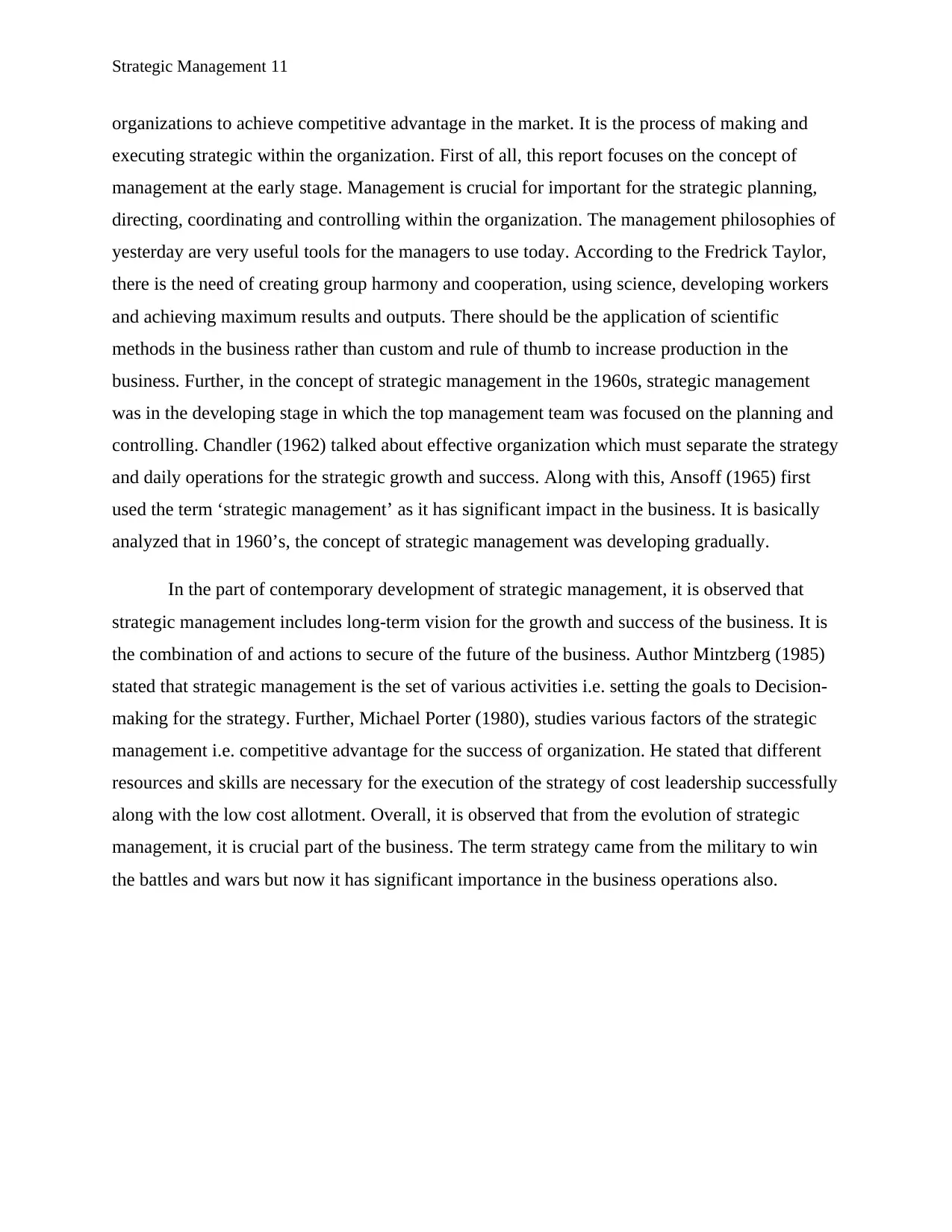
Strategic Management 11
organizations to achieve competitive advantage in the market. It is the process of making and
executing strategic within the organization. First of all, this report focuses on the concept of
management at the early stage. Management is crucial for important for the strategic planning,
directing, coordinating and controlling within the organization. The management philosophies of
yesterday are very useful tools for the managers to use today. According to the Fredrick Taylor,
there is the need of creating group harmony and cooperation, using science, developing workers
and achieving maximum results and outputs. There should be the application of scientific
methods in the business rather than custom and rule of thumb to increase production in the
business. Further, in the concept of strategic management in the 1960s, strategic management
was in the developing stage in which the top management team was focused on the planning and
controlling. Chandler (1962) talked about effective organization which must separate the strategy
and daily operations for the strategic growth and success. Along with this, Ansoff (1965) first
used the term ‘strategic management’ as it has significant impact in the business. It is basically
analyzed that in 1960’s, the concept of strategic management was developing gradually.
In the part of contemporary development of strategic management, it is observed that
strategic management includes long-term vision for the growth and success of the business. It is
the combination of and actions to secure of the future of the business. Author Mintzberg (1985)
stated that strategic management is the set of various activities i.e. setting the goals to Decision-
making for the strategy. Further, Michael Porter (1980), studies various factors of the strategic
management i.e. competitive advantage for the success of organization. He stated that different
resources and skills are necessary for the execution of the strategy of cost leadership successfully
along with the low cost allotment. Overall, it is observed that from the evolution of strategic
management, it is crucial part of the business. The term strategy came from the military to win
the battles and wars but now it has significant importance in the business operations also.
organizations to achieve competitive advantage in the market. It is the process of making and
executing strategic within the organization. First of all, this report focuses on the concept of
management at the early stage. Management is crucial for important for the strategic planning,
directing, coordinating and controlling within the organization. The management philosophies of
yesterday are very useful tools for the managers to use today. According to the Fredrick Taylor,
there is the need of creating group harmony and cooperation, using science, developing workers
and achieving maximum results and outputs. There should be the application of scientific
methods in the business rather than custom and rule of thumb to increase production in the
business. Further, in the concept of strategic management in the 1960s, strategic management
was in the developing stage in which the top management team was focused on the planning and
controlling. Chandler (1962) talked about effective organization which must separate the strategy
and daily operations for the strategic growth and success. Along with this, Ansoff (1965) first
used the term ‘strategic management’ as it has significant impact in the business. It is basically
analyzed that in 1960’s, the concept of strategic management was developing gradually.
In the part of contemporary development of strategic management, it is observed that
strategic management includes long-term vision for the growth and success of the business. It is
the combination of and actions to secure of the future of the business. Author Mintzberg (1985)
stated that strategic management is the set of various activities i.e. setting the goals to Decision-
making for the strategy. Further, Michael Porter (1980), studies various factors of the strategic
management i.e. competitive advantage for the success of organization. He stated that different
resources and skills are necessary for the execution of the strategy of cost leadership successfully
along with the low cost allotment. Overall, it is observed that from the evolution of strategic
management, it is crucial part of the business. The term strategy came from the military to win
the battles and wars but now it has significant importance in the business operations also.
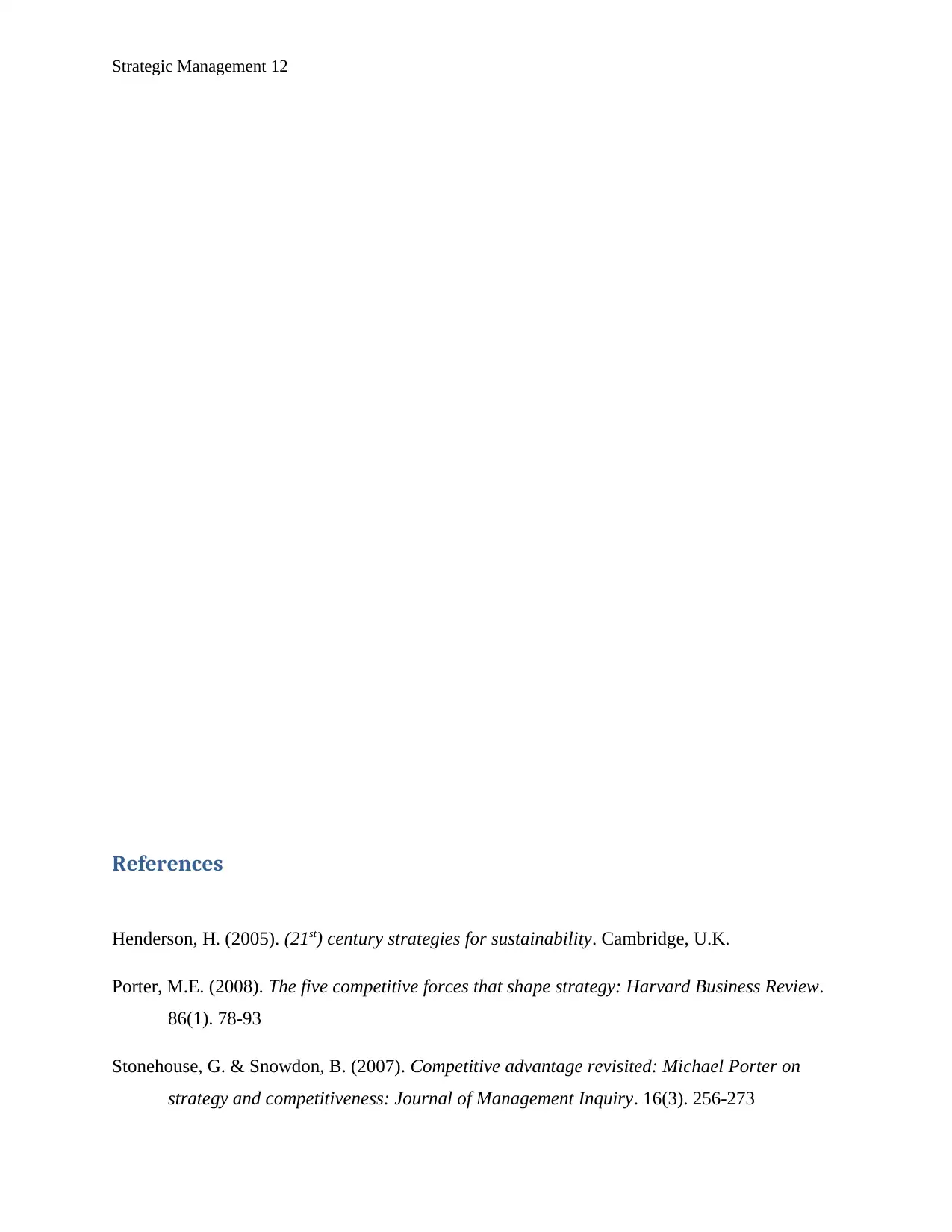
Strategic Management 12
References
Henderson, H. (2005). (21st) century strategies for sustainability. Cambridge, U.K.
Porter, M.E. (2008). The five competitive forces that shape strategy: Harvard Business Review.
86(1). 78-93
Stonehouse, G. & Snowdon, B. (2007). Competitive advantage revisited: Michael Porter on
strategy and competitiveness: Journal of Management Inquiry. 16(3). 256-273
References
Henderson, H. (2005). (21st) century strategies for sustainability. Cambridge, U.K.
Porter, M.E. (2008). The five competitive forces that shape strategy: Harvard Business Review.
86(1). 78-93
Stonehouse, G. & Snowdon, B. (2007). Competitive advantage revisited: Michael Porter on
strategy and competitiveness: Journal of Management Inquiry. 16(3). 256-273
⊘ This is a preview!⊘
Do you want full access?
Subscribe today to unlock all pages.

Trusted by 1+ million students worldwide
1 out of 14
Related Documents
Your All-in-One AI-Powered Toolkit for Academic Success.
+13062052269
info@desklib.com
Available 24*7 on WhatsApp / Email
![[object Object]](/_next/static/media/star-bottom.7253800d.svg)
Unlock your academic potential
Copyright © 2020–2025 A2Z Services. All Rights Reserved. Developed and managed by ZUCOL.





